Cleaning the interior of a 65-year-old car using the latest dry ice and dry snow blasting/cleaning technologies
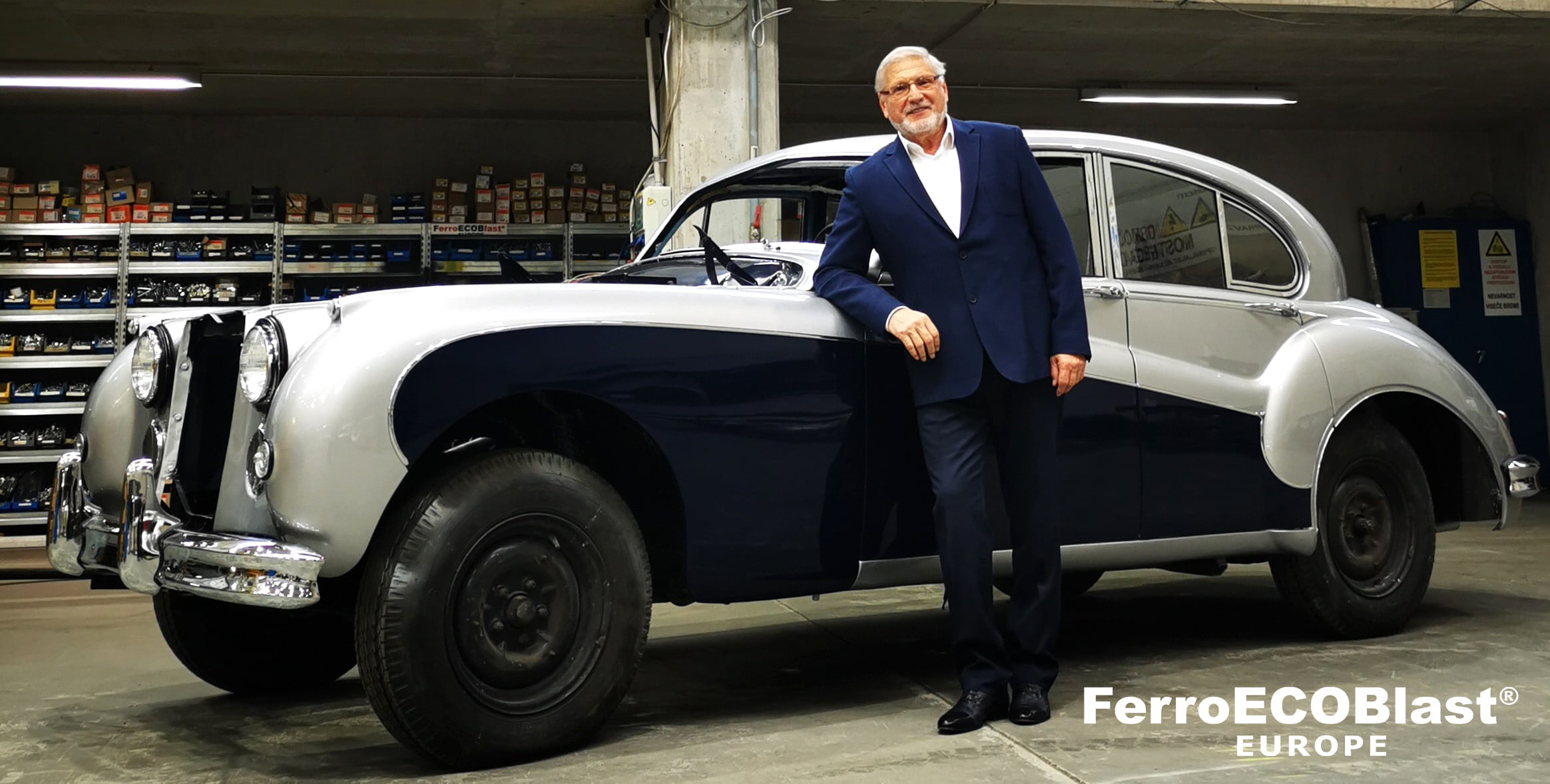
Our blog this time around is a little different, with a popular and also professional theme, and above all it features a personal touch from our mentor and founder of FerroČrtalič d.o.o., Mr. Bojan Črtalič.
Dear friends of FerroECOBlast® Europe and all fans of antique “Oldtimer” cars in particular!
This blog is dedicated to one of my personal projects which I’m very happy to tackle towards close to the end of my business career – it’s helping me make a soft transition into the third stage of my life.
We will talk about a "JAG restoration project", or more specifically, about cleaning the interior of a 65-year-old car using the latest dry ice and dry snow blasting/cleaning technologies. Dry ice cleaning really is an exceptional technology, but unfortunately quite expensive and – despite its great advantages – is less commonly used in car servicing and restoration.
This blog is a story about the legendary Jaguar MK-8 Saloon (a model from the 1950s, (close to the times of Al Capone, haha), which had been gathering dust in an abandoned warehouse for decades. I’d been toying long time with the idea of buying some rare, old Jaguar limousine with the steering wheel on the left-hand side, one that was not yet renovated but was in good condition (I wanted to do the restoration myself). Years of searching for the right model and manufacture year eventually paid off – I’ve been finally lucky enough to have found it!
I bought this abandoned 1958 car and decided to restore it to its former splendor and glory, so that it would make me and my family happy and would look awesome on our Slovenian roads in particular.
Like most stories about antique cars, mine too is a bit specific, but anyhow, every renovating project should kick off with a detailed action plan and timeline, which is precisely the same how we do things at our company, making sure all processes diligently monitored, photographed, and documented.
The car was in terrible condition. Body and chrome parts rusted everywhere, the original paint was so worn that it was difficult to make out the car’s original color, the interior trim and seats were completely worn out and destroyed, the engine did not work… But when you fall in love, you tend to see things through rose-coloured glasses: the car didn’t look so bad on the day I bought it, the engine too started with some difficulty, at least in my imagination, the brakes, clutch and many electric parts didn’t work at all – but for me, I’m sure it will drive smoothly (one day)… On top of that, when the gentleman offered to sell it at an affordable price, we immediately shook hands to seal the deal.
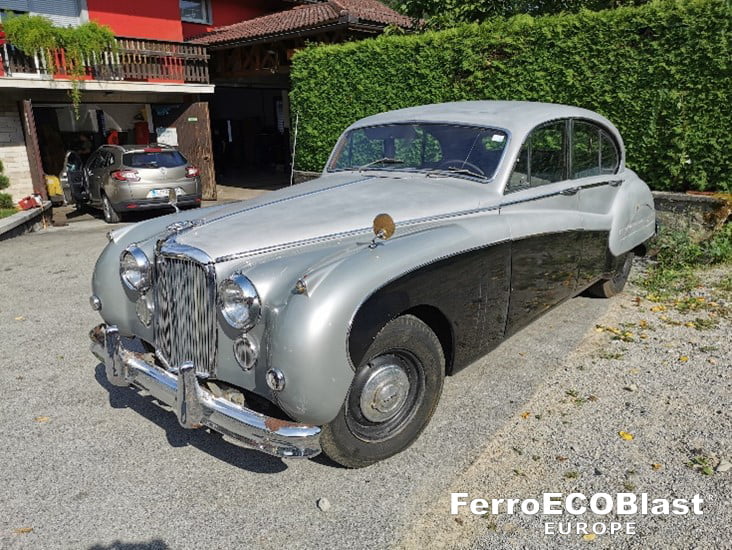
Image 01/02: Jaguar MK-8 Saloon, produced in mid-1958 – Before restoration
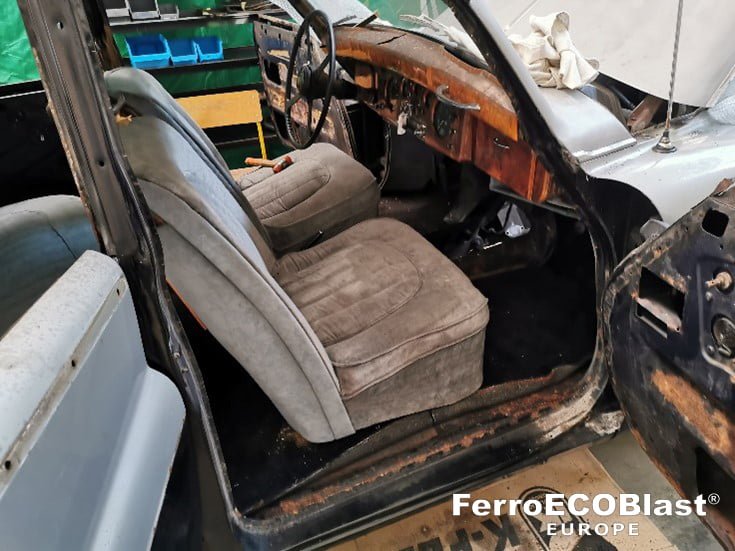
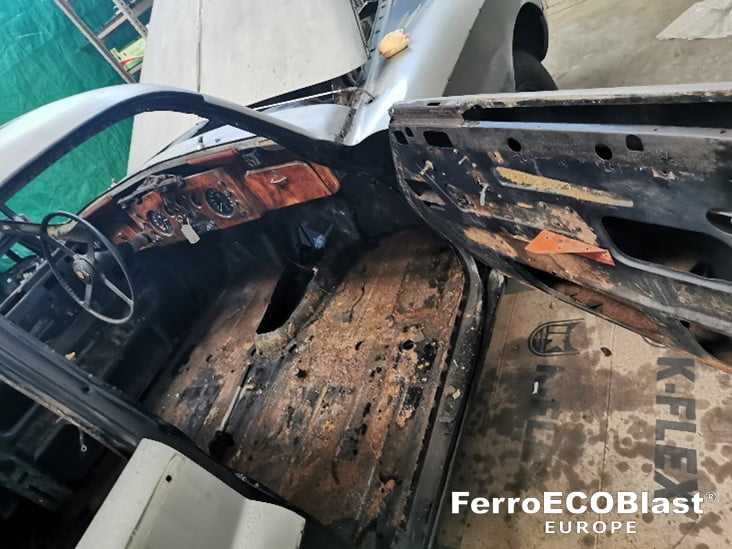
Image 03/04: Oh dear, what to do with such a dirty, rusty and ugly interior and trunk?

Today, this Oldtimer car is completely restored: we dismantled and stripped it apart practically to the last screw, cleaned the entire body and chassis with dry ice (used approx. 650 kilograms), welded critical areas and sealed them in the original way... The bottom of the vehicle is now again completely healthy and better protected than when it was brand new!

Image 05/06: Dry Ice Equipment/Blaster BL-60 and cleaning with dry ice pellets
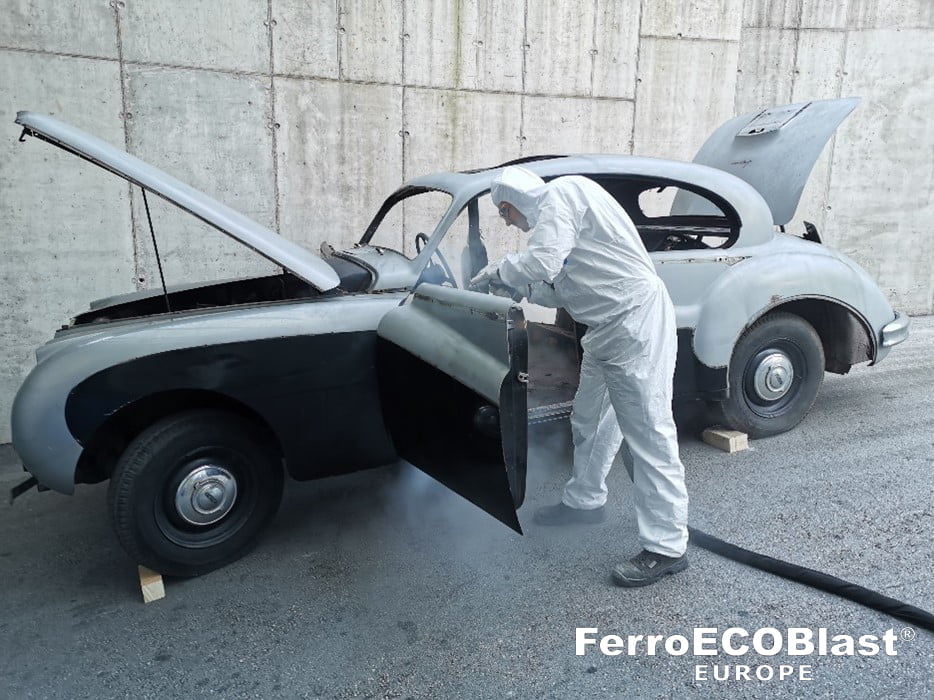
As shown in the pictures, using dry ice we were able to remove all the heavy rust and dirt everywhere inside the car, stripping the interior to raw steel. We didn’t need to disassemble many non-essential parts, we were able to reach every small hole and tight corner, and most importantly, we didn’t use any abrasives, water-detergents, or chemicals for this job!
In all, my friends and I spent around 3 months and many, many man-hours on first dismantling the complete interior of the car. After that, we put in around 36 hours for merely cleaning and blasting the interior, doors and trunk with dry ice/snow, logging in – with preparation and some additional miscellaneous work – more than 60 hours.

Image 07/08: Dry Ice Equipment/Blaster BL-60 and cleaning with dry ice pellets
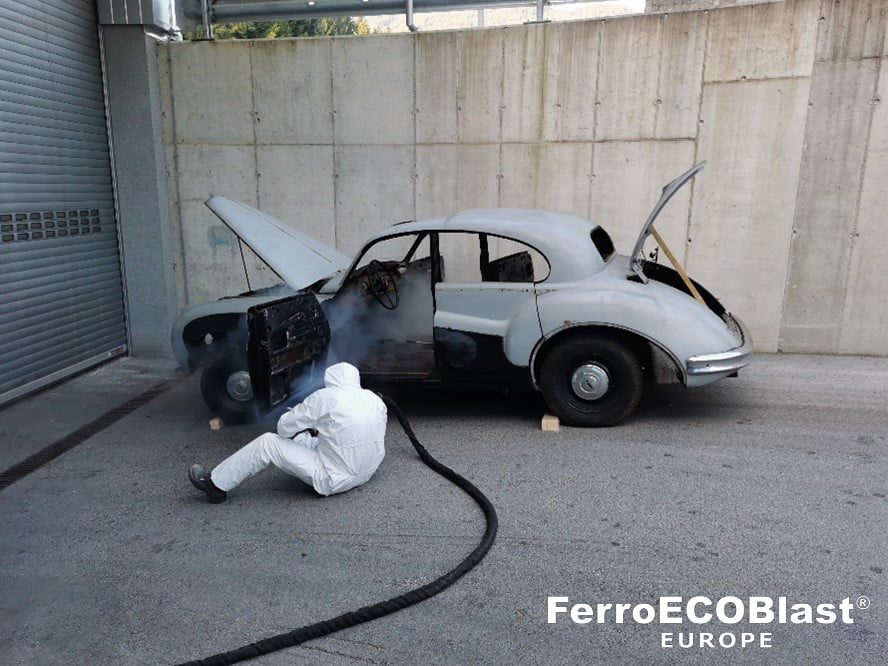
Here’s a rough overview of the effort put into the dry ice cleaning of the interior and trunk:
- preparation of surfaces for cleaning (after dismantling): 2 hours
- preparation and start-up of the cleaning equipment: 1 hour
- cleaning rusty and dirty interior to get clean sheet metal: 30 hours
- cleaning the trunk and all 4 passenger doors: 6 hour
- cleaning the dashboard, electrical wiring – with dry snow: 4 hours
- cleaning the workspace and surroundings: 0.5 hours
- dry ice pellets (3 mm) consumption: 650 kg
- compressed air consumption (8 bar, 7 Nm3/min) 40 hours
- electricity consumption (single-phase, 1.5 kW) 50 kWh
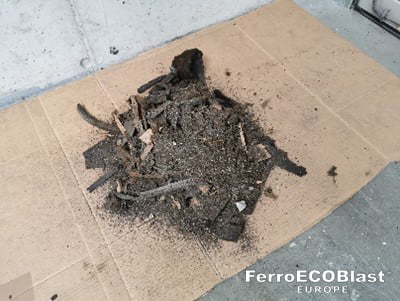
Image 09/10/11: The remaining debris after dry ice cleaning, and a view of clean metal surfaces
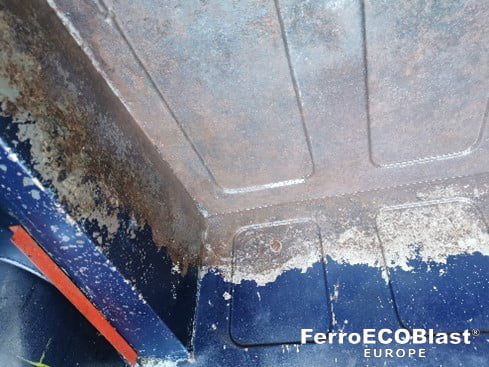
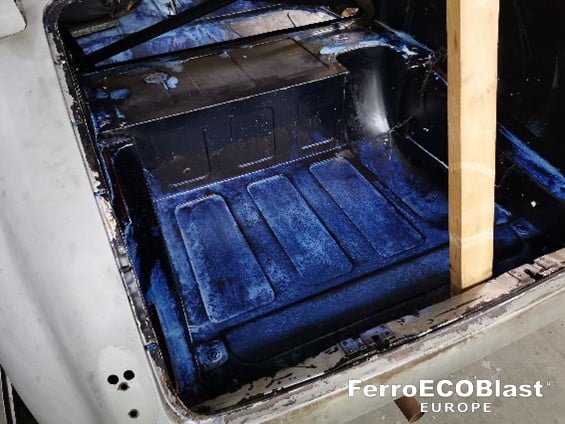
As shown in the table and the pictures, we did a great job – and seeing the end result was the sweetest: the car’s interior and all the doors and trims were perfectly clean, dry,a without as much as a single trace of dirt or powder. And we cleaned up the surroundings in a flash... All thanks to the exceptional dry ice cleaning technology! To learn more about the dry ice technology, visit our web page FerroECOBlast.
After rustproofing the interior and trunk based on expert guidance and material from the laboratory of Slovenian-based Kansai-Helios Paint Company, the complete interior has been restored and replaced in the original way: the wooden parts repaired and polished, the door trim and seats completely disassembled and replaced with original ones, other metal parts gently sandblasted and painted or chromed. A Slovenian artisan upholsterer was entrusted with producing a new, close-to-original upholstery from old-fashion clothing, which turned out to be better and more beautiful car interior than the original.

Image 12/13: After cleaning, rust-removal acid was applied and the surfaces were primer was applied and final painted for protection
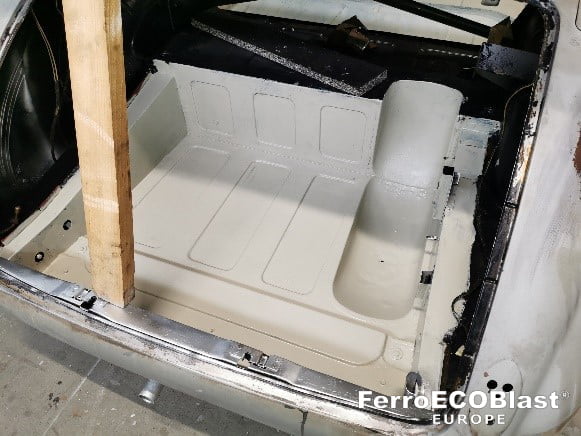
The attached pictures clearly show the size and scale of the restoration project and why it has been going on for two and a half years – with COVID also being one the main reasons for the considerable delay...
It took me two and a half years to rebuild the chassis, complete a new two-tone paintwork, polish and re-chrome all the shiny parts, change the electric wiring and renew all the lights, completely replace the brake pads and cylinders with new, but still original ones, sourced mostly from the same suppliers whose histories go back to those old times. A seasoned classic engine mechanic looks after the engine, which brightly shines from under the bonnet and spins like a contented English cat-Jag.
And now I get to ride happily in nice weather and really enjoy taking my wife, grandsons and granddaughters for an enjoyable ride…
Wishing you a nice, great day, happy driving, and many pleasures in life.
Your sincerely,
Bojan Črtalič
